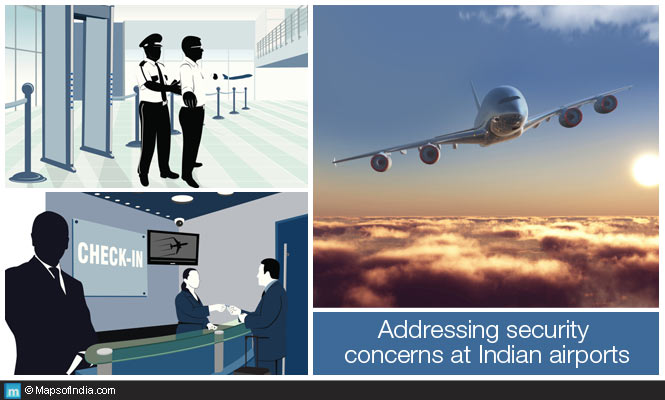 The security of airports in India is the responsibility of the Bureau of Civil Aviation Security. The bureau was set up on the recommendation of the Pande Committee after an Indian Airlines flight was hijacked in September 1976. Since then there has been a lot of improvement in the functioning of airports (at least international airports).
The security of airports in India is the responsibility of the Bureau of Civil Aviation Security. The bureau was set up on the recommendation of the Pande Committee after an Indian Airlines flight was hijacked in September 1976. Since then there has been a lot of improvement in the functioning of airports (at least international airports).
However, if you look at the proper functioning of an Indian airport you would realize that there exist a lot of procedures, which are redundant. The next time you go to any airport in India, just pay attention to the number of times your tickets with ID is checked. It is checked about three to four times depending on the airport. This is done probably for security reasons, but in India, tickets are checked even at the entrance. No other nation does that. It also means that your loved ones will have to bid you farewell outside the airport as they are not allowed to enter. This might be because in India we have a culture of an entire family coming over to see off guests, resulting in overcrowding. Hence, checking of tickets might be a redundant activity in Indian Airports but it could be looked upon as a crowd management activity.
Two major gaps or flaws during the security check-in procedure in India could be:
- Metal Detectors: At foreign airports the person is frisked using a hand scanner only after the person gets-off the metal detector. However, in India, the metal detectors are usually either switched off or act as mere doorways.
- Shoes and other items: It is rare in our country to check shoes during the security check-in. At other international airports your shoes might also be scanned. At foreign airports, liquids are usually not allowed during check-in, however, in many Indian airports people can be seen carrying such items.
Severe Flaws in Airport Security
A recent accident further highlighted the flaws in Indian Airport security. At Surat Airport, a Jet Airways Boeing was preparing to take off when it hit a buffalo on the runway. None of the security personnel was able to tell as to how the buffalo reached the runway. The accident damaged one of the twin engines of the jet and grounded the airplane. The incident created an alarm as to how such a big animal could cross the fenced limit of the airport and reach the runway undetected, to which one of the executives answered, “The buffalo was invisible against a dark background.”
There are also lounges at the airport for government officials and other VIPs. In the USA, the VIP lounges are available only for cabinet-rank dignitaries. Further, this facility cannot be purchased. In the UK, the VIP suites are operated on commercial basis and range from UK £ 400 to UK £ 1000 depending on the size of the delegation. In India, the VIP lounges are available for cabinet level dignitaries and above. This facility comes for free, probably out of courtesy.
Recently, there was a press release regarding the civil aviation minister inspecting the Chennai Airport. The major conclusion was that the airport lacks green posture and so, the minister has decided to consult a professional horticulture consultant to give the airport a facelift. He further said that any infrastructural adjustments, which would benefit the passengers, should immediately be looked into. This is a step in the right direction. However, a major gap which I personally felt during one of my recent travels to Chennai in January 2015 was that the check-in area was causing unnecessary delays and a lot of passengers were stuck in the check-in line for around 30 minutes. The reason I detected was that the procedure where we are supposed to remove all electronic items, jackets, among others and put it in the bin for scanning is very time consuming. I would have not bothered to complain if the reasons of delay were security issues. However, the real cause was the lack of enough bins. Moreover, the bins were being manually handed to each passenger by a security personal. It is not the same in any other airport elsewhere, wherein the bins are stacked and kept and the passengers can take the bins themselves, (more like self-service), which makes the procedure faster.
In conclusion, the security at Indian Airports has improved after a few hijacking incidents and accidents but still security issues at Indian airports are being neglected. This attitude should change. There are numerous experiences and stories of security breach at Indian Airports which should be more carefully dealt with.
Related Information:



